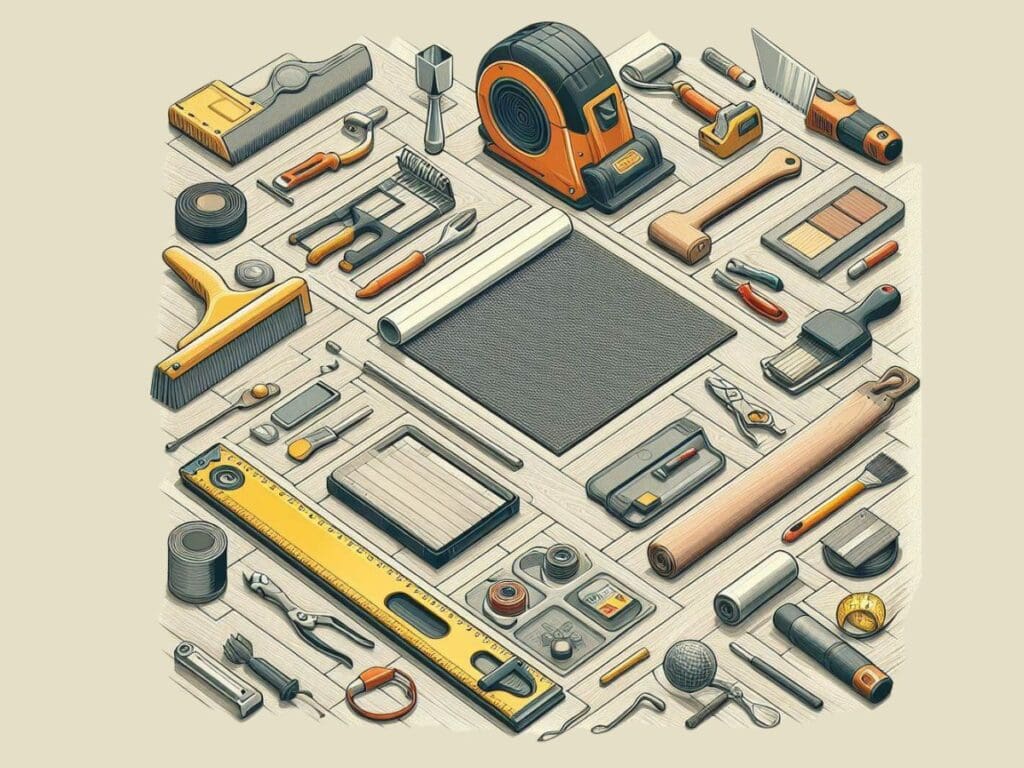Flooring projects are among the most popular DIY home improvements, largely due to the significant cost savings and the ability to customize your space exactly how you envision it. Whether you’re considering laminate that mimics luxurious hardwood, durable vinyl for high-traffic areas, or classic ceramic tiles for a sleek kitchen or bathroom, the choices are endless.
But, beyond the aesthetic appeal, the satisfaction of laying your own flooring is unmatched, giving you a sense of achievement and a personal touch to your home. Different flooring materials offer varied benefits and challenges.
You should know how to choose the right material, prepare the necessary tools, and execute your flooring project with precision, whether you’re a seasoned DIY enthusiast or a first-timer ready to roll up your sleeves! Lets look at some DIY Flooring projects.
Step 1: Planning Your Project
To ensure success, careful planning is necessary before beginning a do-it-yourself flooring job. This includes finishing the first steps of choosing the ideal flooring material for your area, putting together the required equipment and supplies, and efficiently allocating your money and time.
To establish a solid foundation for your project, each step is essential.

1. Choosing the Right Flooring Material
Selecting the appropriate flooring material is the first critical step in your DIY project. The specific needs of your space should guide this choice, along with your personal style preferences and the practical aspects of installation and maintenance.
Factors to Consider:
- Durability: Assess the level of traffic and wear the floor will need to withstand.
- Room Use: Kitchens and bathrooms need moisture-resistant materials, while living areas may require more comfort or aesthetic appeal.
- Aesthetics: Choose a material that complements the existing décor and meets your stylistic preferences.
Pros and Cons of Popular Materials:
Laminate:
- Pros: Cost-effective, diverse designs, easy installation.
- Cons: It is not very moisture-resistant and can be slippery.
Hardwood:
- Pros: Increases home value, can be refinished, and has timeless appeal.
- Cons: Susceptible to scratches, can be expensive, sensitive to moisture.
Tile:
- Pros: Durable, moisture-resistant, ideal for high-traffic areas.
- Cons: Hard underfoot, cold, challenging installation.
Vinyl:
- Pros: Water-resistant, budget-friendly, versatile styles.
- Cons: It can emit VOCs and is less durable than tile or hardwood.
2. Tools and Materials Needed
Having the right tools and materials at hand is essential for a smooth DIY flooring project. Make sure you gather everything before you start to avoid interruptions.

Basic Toolkit Requirements:
- Tape measure
- Utility knife
- Flooring cutter or saw
- Tapping block and pull bar
- Rubber mallet
- Level
- Spacers
Additional Materials:
- Underlayment: Necessary for most laminate and engineered wood installations.
- Adhesives: These are required for certain types of tile and some wood installations.
- Finishes: Sealers or varnishes if needed, especially for wood floors.
3. Budgeting and Timeline
Planning your budget and timeline effectively can make the difference between a project that feels rewarding and one that becomes a source of stress.

Estimating Costs:
- Materials: Calculate based on square footage plus an additional 10% for waste.
- Tools: Include any tools you need to purchase or rent.
- Unexpected Costs: Always plan for a little extra for unexpected issues.
Planning Your Timeline:
- Preparation: Include time for room and subfloor preparation.
- Installation: Depends on the size of the area and the type of flooring.
- Finishing Touches: Allow time for trimming, curing, or drying as needed.
| Phase | Duration | Notes |
| Preparation | 1-2 days | Cleaning, measuring, subfloor prep |
| Installation | 3-5 days | Varies by flooring type and room size |
| Finishing | 1-2 days | Trimming, sealing, drying |
Step 2: Preparation
Proper preparation is key to ensuring a successful DIY flooring project. This entails measuring and buying your materials, as well as preparing the subfloor, which can dramatically affect the appearance and longevity of your new flooring.
Taking the time to prepare thoroughly will minimize potential issues during the installation process.
1. Measuring and Purchasing
Accurate measurements and smart purchasing decisions are fundamental to avoiding delays and excessive costs. Here’s how to get it right from the start:
How to Measure Your Room Accurately:
- Measure the length and width of the room at its longest and widest points.
- Multiply these numbers to get the total square footage.
- Add 10% to the total for waste, especially important in tile projects for cuts and breaks.
Tips on Buying the Right Amount of Materials:
- Always check the batch numbers on the flooring to ensure color and pattern consistency.
- Purchase a little extra material in case of future repairs or mistakes.
- Consider the delivery times and availability of the materials to coordinate with your project timeline.
2. Preparing the Subfloor
The subfloor is the foundation for your new flooring, and its condition is crucial to avoid complications like uneven surfaces or moisture problems.
Importance of a Clean, Dry, and Level Subfloor:
- A clean subfloor helps ensure proper adhesion of materials like tiles and certain types of hardwood.
- Moisture can warp wood and cause mold issues, so ensure the subfloor is dry.
- An uneven subfloor can lead to a spongy feel and premature wear; use a level to check flatness.
Steps to Prepare the Subfloor for Installation:
- Cleaning: Remove all debris, dust, and existing flooring materials.
- Leveling: Use a leveling compound to fill in low spots and sand down high spots.
- Moisture Testing: This is especially important in basements and ground floors. Use a moisture meter to ensure acceptable levels.
- Repairs: Fix any cracks or damage that could affect the new flooring.
Subfloor Preparation Checklist:
Clean the entire surface thoroughly.
Level the floor using a leveling compound if necessary.
Conduct moisture tests and address any issues.
Make necessary repairs to damaged areas.
Step 3: Installation Techniques
Proper installation is crucial for ensuring the longevity and appearance of your new flooring. This includes having the necessary specific techniques for installing different types of flooring materials.
Each type has its unique method, and understanding these can help you achieve professional-looking results, even as a DIYer.
1. Installing Different Types of Flooring
Different flooring options require distinct approaches during installation. Here’s a step-by-step guide for some of the most popular materials:
Laminate Flooring:
Preparation: Ensure the subfloor is level and clean. Lay down the underlayment to provide a smooth surface and moisture barrier.
Installation:
- Start in a corner and work left to right.
- Place spacers along the walls to allow for expansion.
- Use a tapping block and mallet to fit planks snugly together without damaging the edges.
- Stagger seams by using different lengths of planks at the start of new rows.
Finishing: Install baseboards to cover the expansion gaps. Do not attach baseboards to the flooring itself.
Hardwood Flooring:
Preparation: Check wood planks for defects. Acclimate the hardwood to the room’s humidity and temperature for at least 48 hours.
Installation:
- Begin at the longest, most visible straight wall.
- Attach each plank with nails or staples through the tongue at a 45-degree angle.
- Use a floor nailer to secure planks, maintaining a consistent expansion gap around the perimeter.
- Sand any uneven sections if necessary.
Finishing: Apply stain and sealant if using unfinished wood. Pre-finished planks may just need a touch-up on nails and joints.
Vinyl Flooring:
Preparation: The subfloor must be perfectly smooth and clean.
Installation:
- For sheets, roll out and trim to fit, securing edges with adhesive if necessary.
- For tiles or planks, start at the center of the room, laying each piece by peeling the back and sticking them down.
- Use a roller to firmly press the vinyl into place.
Finishing: Seal seams if needed to prevent water penetration, especially in bathrooms and kitchens.
Tile Flooring:
Preparation: Apply a layer of mortar or self-leveling compound to ensure an even subfloor.
Installation:
- Lay out tiles to check the fit and pattern before applying adhesive.
- Spread thin-set using a notched trowel, working in small sections.
- Place tiles gently but firmly into the thin set, using spacers to maintain even gaps.
- Cut tiles as needed to fit around corners and edges using a wet saw or tile cutter.
Finishing: Once the adhesive has set, remove spacers and apply grout. Seal the grout to enhance durability and ease of cleaning.
2. Dealing with Obstacles
During installation, you may encounter various obstacles such, as pipes, corners, or irregular spaces. Here’s how to handle these challenges:
Cutting around Corners and Door Frames:
- Measure the precise space and mark the tile or plank.
- Use a jigsaw for laminate or vinyl and a tile cutter for ceramic tiles.
- Fit the flooring snugly around the obstacle for a clean finish.
Managing Transitions Between Different Floors:
- Use transition strips to connect different flooring types gracefully.
- Ensure that the transition not only looks good but also allows for the natural expansion and contraction of the flooring materials.
Step 4: Finishing Touches
After successfully laying down your new flooring, the final steps are crucial for ensuring a professional appearance and long-term durability. This includes the essential finishing touches, including trim installation and sealing, necessary to protect and enhance your flooring project.
1. Trim and Moldings
Trim and moldings are not just decorative elements; they play a vital role in covering expansion gaps and transitions between different flooring types or meeting walls. Proper installation of these components is essential for a clean and finished look.
Choosing and Installing Appropriate Trim:
- Baseboards: These are used to cover the joint between the wall and the floor. They should be attached to the walls, not the flooring, to allow for floor expansion and contraction.
- Quarter Rounds: Installed at the base of baseboards, these cover smaller gaps and give a polished look.
- Thresholds or Transition Strips: These are used where the flooring meets different flooring types or features like doorways. They help to bridge the gap smoothly and prevent tripping hazards.
Techniques for a Professional Look:
- Measure and cut each piece accurately to ensure tight joints and corners.
- Use a miter saw for precise cuts, especially for corners and complex angles.
- Secure trim and moldings with finish nails and use wood filler to cover nail holes for a seamless appearance.
- Paint or stain trim and moldings to match or complement your flooring and room decor.
2. Sealing and Finishing
The sealing process can significantly extend the life of certain flooring types by protecting against moisture, dirt, and wear.
Necessary Steps for Different Materials:
- Hardwood: Apply a final coat of sealer or polyurethane after installation to protect the wood from scratches and moisture.
- Tile: Seal the grout lines to prevent staining and moisture penetration, especially important in wet areas like bathrooms and kitchens.
- Laminate and Vinyl: Typically do not require sealing, but edges and seams can be sealed in high moisture areas to prevent water damage.
Longevity and Protection of Your New Floor:
- Regular maintenance, such as sweeping and occasional mopping, is crucial for keeping floors in top condition.
- Use furniture pads to protect floors from scratches and placemats at entrances to catch dirt and grit.
Waterproof vs. Water-Resistant Flooring
Starting a do-it-yourself flooring project may be quite fulfilling and greatly impact your living area. Adhering to thorough instructions can help you be confidently prepared to take on your flooring project.
Knowing the distinction between water-resistant and waterproof flooring is important before choosing your choices. This difference is significant because it impacts how long your flooring will last and how durable it will be, especially in households with pets, kids, or high levels of humidity.
It’s important to keep in mind that the quality of your flooring installation can greatly impact the appearance and use of your room, so your work will demonstrate your abilities and increase the value of your house.


